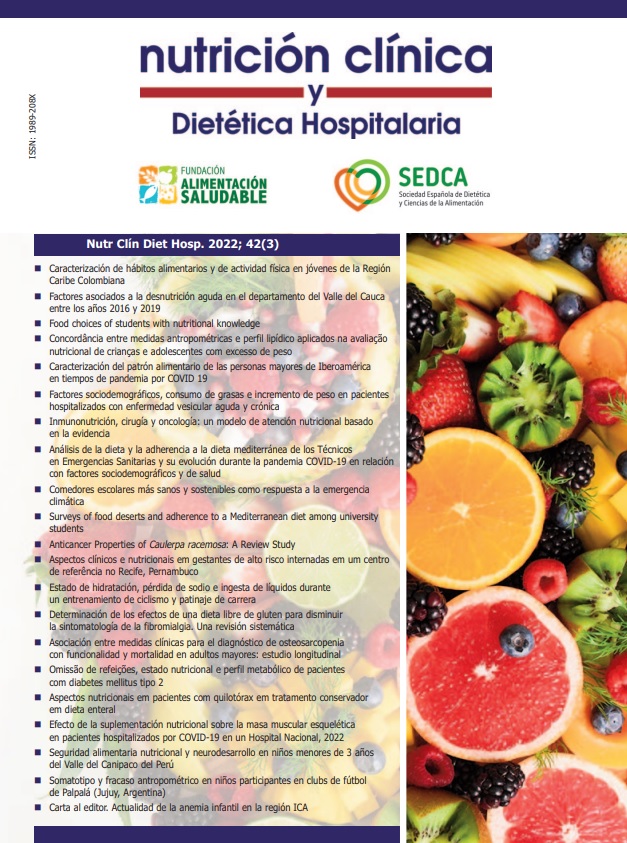Estado de hidratación, pérdida de sodio e ingesta de líquidos durante un entrenamiento de ciclismo y patinaje de carrera.
DOI:
https://doi.org/10.12873/423berdugoPalabras clave:
Palabras Claves: Sudoración; deshidratación; deportistas; hidratación.Resumen
Introducción: La deshidratación aguda afecta la función cognitiva y la concentración, especialmente cuando el deportista está expuesto a ambientes calurosos, al mismo aumentan la percepción del esfuerzo. Un método de prevención es medir el estado de hidratación del deportista y determinar las necesidades individuales de líquidos.
Objetivo: Determinar el estado de hidratación, pérdida de sodio e ingesta de líquidos durante un entrenamiento de ciclismo y patinaje de carrera.
Métodos: 75 deportistas, 35 pertenecientes a patinaje de carrera y 40 a ciclismo de pista de nivel elite. Las pruebas se realizaron por deporte en momentos diferentes del día con una duración de 1.9±0.2 hora de entrenamiento.
El estado de hidratación inicial se estimó a través de la gravedad específica de la orina con un refractómetro digital ATAGO Pal10-S; se colocó en el antebrazo izquierdo un parche absorbente para determinar la concentración de sodio en el sudor durante la sesión de entrenamiento utilizando un medidor de sodio portátil LAQUAtwin-Na-11HORIBA y se calculó la tasa de sudoración a partir de las diferencias del peso corporal, el líquido y alimentos ingeridos.
Resultados: el 28% inicio el entrenamiento con deshidratación GEO > 1.026, La tasa de sudoración para ciclismo y patinaje entre moderada, alta y muy alta represento el 80% y 85% respectivamente, una media de 1,3± 0,9 L/h y 1,2± 0,4 L/h ; se observó que más del 80% de los deportistas finalizó con una deshidratación mínima, perdiendo 1,2 ±1,5% y 1±0,5 % de la masa corporal. La pérdida de sodio promedió fue mayor en ciclismo 2 ±1,2 g y en el sexo masculino 2,1±1,1 g.
Conclusiones: A mayor pérdida de sodio mayor es la tasa de sudoración. El consumo de líquido durante el entrenamiento no es suficiente para reponer la deshidratación inicial y cubrir los requerimientos hídricos para un entrenamiento.
Referencias
Jeukendrup A, Gleeson M. Nutrición deportiva. Madrid: Tutor; 2019. p. 253-113.
Burke L. Nutrición en del deporte: un enfoque práctico. España: Panamericana; 2007, p. 300.
Coldeportes. Colección 1 de los lineamientos de Política Publica en ciencias del de Deporte en Nutrición. Colombia: Coldeportes;
, p. 81-85.
Bean A. Guía completa de la nutrición del deportista. 4ª ed. Badalona: Paidotribo; 2011. p. 125-140.
Martínez S. Plan nutricional para un ciclista en la disciplina mountain bike. Rev Nutrición Clínica y Dietética Hospitalaria. 2020; 40(3):180-184. DOI: 10.12873/403martinez
Palacios N, Bonafonte LF, Manonelles P, Manuz B, Villegas JA. Consensus on drinks for the sportsman. Composition and guidelines of replacement of liquids. Document of consensus of Spanish Federation of Sports Medicine. Arch Med Deporte. 2008; 25(127): 58-245.
Colegio Americano de Medicina del Deporte. Ejercicio y reposición de líquidos. Medicine & Science in Sports & Exercise. 2007; 39(2).
Kreider RB, Wilborn CD, Taylor L, Campbell B, Almada AL, Collins R, Cooke M, Earnest CP, Greenwood M, Kalman DS, Kerksick CM,
Kleiner SM, Leutholtz B, Lopez H, Lowery LM, Mendel R, Smith A, Spano M, Wildman R, Willoughby DS, Ziegenfuss TN, Antonio J.
ISSN exercise & sport nutrition review: research & recommendations. Journal of the International Society of Sports Nutrition.
; 7: 7.
Armstrong LE, Pumerantz AC, Fiala KA, Roti MW, Kavouras SA, Casa DJ, Maresh CM. Human hydration indices: acute and longitudinal reference values. International journal of sport nutrition. 2010; 20(2): 145.
Lindsay B. Metodología de pruebas de sudor en el campo: retos y mejores prácticas. Sports Science Exchange. 2017; 28(161): 1-
Scaglioni P. Ingesta voluntaria de líquido y cambio en el gusto con opción de dos bebidas durante entrenamiento en ciclismo. Pensar
en movimiento: Revista de Ciencias del Ejercicio y la Salud. 2008, 6(1): 24-33.
Larson N, DeWolfe J, Story M, Neumark-Sztainer D. Adolescent Consumption of Sports and Energy Drinks: Linkages to Higher
Physical Activity, Unhealthy Beverage Patterns, Cigarette Smoking, and Screen Media Use. J Nutr Educ Behav. 2012; 46(3):
–7. http://dx.doi.org/10.1016/j.jneb.2014.02.008
Minehan MD, Riley MR, Burke LM. Effect of flavor and awareness of kilojoule content of drinks on preference and fluid balance in
team sports. International Journal of Sports Nutrition. 2002; 12:81-92.
Knechtle B, Knechtle P, Rosemann T. No case of exercise-associated hyponatremia in male ultra-endurance mountain bikers in the “Swiss Bike Masters”. Chin J Physiol. 2011; 54(6): 379-84.
Hew-Butler T, Verbalis JG, Noakes TD. Updated fluids recommendation: position statement from the International Marathon
Medical Directors Association (IMMDA). Clin J Sport Me. 2006;16: 283-92.
Laursen, PB. (2011). Long distance triathlon: demands, preparation and performance. Journal of Human Sport and Exercise.
; 6(2): 231-237. http://ve.scielo.org/scielo.php?script=sci_arttext&pid=S0004-06222004000200004
Selles MC, Martínez-Sanz JM, Mielgo-Ayuso J, Selles S, NorteNavarro A, Ortiz-Moncada R, Cejuela R. Evaluación de la ingesta de líquido, pérdida de peso y tasa de sudoración en jóvenes triatletas. Rev Esp Nutr Hum Diet. 2015; 19(3): 132-139.
Colegio Americano de Medicina del Deporte. Ejercicio y reposición de líquidos. Medicine & Science in Sports & Exercise. 2007; 39(2).
Jeukendrup AE, Currell K, Clarke J, Cole J, Blannin AK. Effect of beverage glucose and sodium content on fluid delivery. Nutr
Metab. 2009; 6: 9.
Kovacs M. Hidratación y Temperatura en el Tenis – Una Revisión Práctica. Journal PubliCE. 2006: 1-9. https://publice.info/articulo/hidratacion-y-temperatura-en-el-tenis-una-revision-practica699-sa-Y57cfb271777aa
López-Samanes A, García-Rojo P. Hidratación en el tenis: Aplicaciones prácticas. Revista Ecoach. 2012; 15: 36-43.
Descargas
Publicado
Licencia
Derechos de autor 2022 Nutrición Clínica y Dietética Hospitalaria

Esta obra está bajo una licencia internacional Creative Commons Atribución-NoComercial-SinDerivadas 4.0.
Los lectores pueden utilizar los textos publicados de acuerdo con la definición BOAI (Budapest Open Access Initiative)



